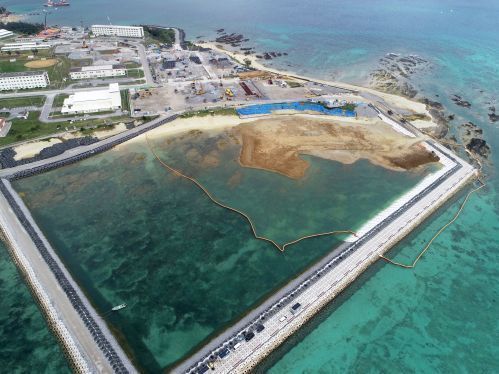Expert claims no previous reinforcement of soft ground 90 meters below sea level, the depth found in Henoko construction area

The progress of land reclamation soil deposits as part of construction of the Futenma Replacement Facility off a shore portion of Camp Schwab on January 18, 2019 at 11:27 a.m. (photograph taken via small drone)
February 7, 2019 Ryukyu Shimpo
On February 6, it came to the Ryukyu Shimpo’s attention that the thickest layer of soft ground at the construction site for the Futenma Replacement Facility (FRF) in Oura Bay reaches a depth of about 90 meters below sea level. This strip requires large-scale ground improvement work as part of construction of the FRF. Up to this point it was believed that the thickest layer reached about 70 meters below sea level, but the Okinawa Defense Bureau (ODB) found upon further investigation that the layer reaches 20 meters deeper than previously known. Associate Professor Shoji Kamao (specialty in geotechnology) of Nihon University’s College of Science and Engineering spoke about the Japanese government’s plans for ground reinforcement work. He pointed out, “As far as I know there are no examples of ground reinforcement work as deep as 90 meters below sea level. I would think that would be difficult for domestic work ships.”
The plan came to light in an ODB investigative report about the ground reinforcement work. This report specified that the reinforcement work was to take place, at deepest, 70 meters below sea level. Professor Kamao commented about what would happen if ground improvement were completed to a depth of 70 meters below sea level, when the layer of weak ground reaches a depth of approximately 90 meters. He predicts, “If improvement stops 20 meters short, soft ground will remain in the layer below, and in the long term ground subsidence is likely to occur.”
From 2014 to 2016, in the ocean area planned for construction of the Henoko base, the ODB conducted initial underwater boring surveys. At that time, the ODB reported that the weak layer reached a depth of about 70 meters. After that the ODB conducted additional boring surveys at about 50 sites throughout Oura Bay and found that the deepest reaching layer of weak seafloor was the spot planned for construction of the C1 seawall, a spot East off the Camp Schwab shore into Oura Bay. The existence of this layer of weak ground reaching 60 meters below the seafloor, which is 30 meters below sea level, was clarified in the recent report. Even within the seawalls, in a portion of the land reclamation area, a thick layer of soft ground at a depth of about 80 meters below sea level was discovered.
A prefectural government official said, “Even presuming that [ground reinforcement work] is a practical possibility, the time and expense of Henoko relocation will not lead to the return of Futenma Air Station as soon as possible.” There is soft ground spread throughout Oura Bay, and the Japanese government is considering ground improvement work that invloves driving approximately 60,000 sand pillars into the ground and compacting them, within a range of about 57 hectares.
(English translation by T&CT and Erin Jones)
Previous Article:Foreign Laborers in Okinawa totals 8,138 at the end of October, 2018, highest ever figure for both people and businesses
Next Article:The devil’s mask that protects Wabiai no Sato
[Similar Articles]
- Soft seafloor precludes marine work yards for temporary caisson storage in FRF construction
- Ground reinforcement means initial sand needs for FRF increase 11-fold, cost rises to 150 billion yen
- Central government considers Henoko seafloor reinforcement method using 60,000 sand pillars
- FRF construction to take at least 13 years, subsequent land subsidence may incur lasting costs
- How far will costs rise? 147.1 billion yen already spent on mere 1% of Henoko land reclamation, prefectural government estimates total of 2.55 trillion
 Webcam(Kokusai Street)
Webcam(Kokusai Street)


